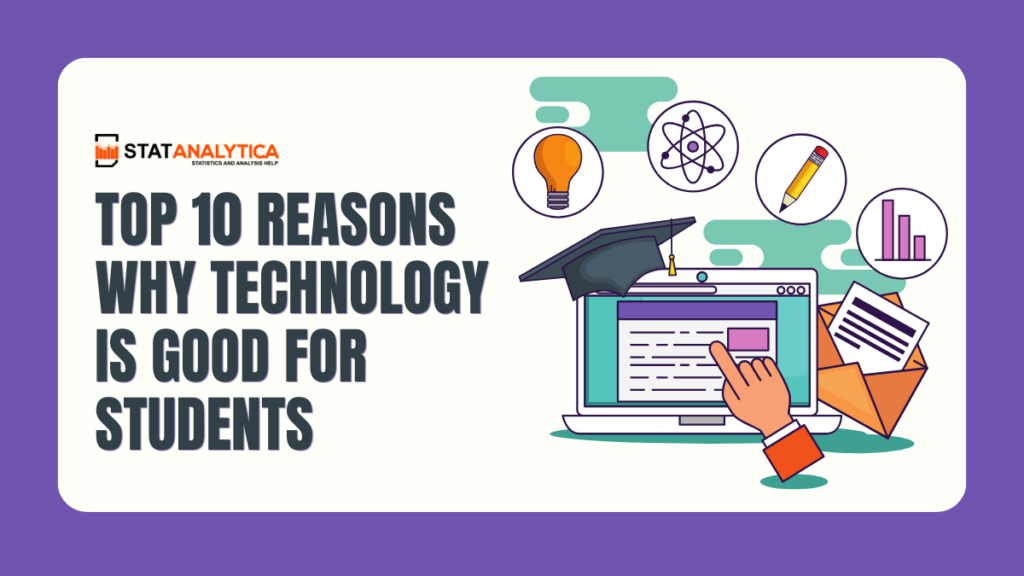Technology has become an undeniable force shaping our world. From the smartphones in our pockets to the complex systems running our cities, technology influences everything from how we communicate to how we learn and live. While there can be concerns about the potential downsides of technology, it’s important to recognize the significant positive impact it has had on our lives. In this blog, we’ll explore 10 reasons why technology is good for students as a whole.

Is Technology Important In Our Life?
Table of Contents
Technology has become unquestionably important in our lives. It permeates nearly every aspect of our daily experiences, influencing how we:
- Communicate: From instant messaging to video conferencing, technology connects us with loved ones and colleagues across the globe, fostering closer relationships and enabling efficient collaboration.
- Learn: Online resources, educational apps, and interactive platforms have transformed learning, granting students access to vast knowledge and personalized learning experiences, fostering a love for continuous learning.
- Work: Automation software, project management tools, and communication platforms streamline workflows, improve productivity, and allow for remote working, enhancing efficiency and flexibility.
- Access Information: The internet serves as a treasure trove of information, empowering individuals to research topics, gain new skills, and stay informed about the world around them.
- Solve Problems: From medical advancements to environmental solutions, technology drives innovation and helps us tackle complex challenges, paving the way for a better future.
- Entertain: Streaming services, gaming platforms, and social media provide various forms of entertainment, helping us relax, connect with others, and explore our interests.
However, it’s crucial to acknowledge that technology has its drawbacks, such as:
- Addiction and Dependence: Excessive reliance on technology can lead to neglect of important aspects of life, social isolation, and potential health concerns.
- Privacy Issues: Sharing personal information online carries privacy risks, requiring conscious choices and responsible digital citizenship.
- Digital Divide: Unequal access to technology can exacerbate social and economic inequalities, highlighting the need for inclusive solutions.
- Ethical Concerns: As technology evolves, ethical considerations regarding artificial intelligence, automation, and data privacy require careful thought and responsible development practices.
Therefore, while technology holds tremendous potential to improve our lives, it’s important to use it consciously and responsibly, acknowledging its limitations and striving to mitigate potential risks.
By striking a balance and fostering responsible practices, we can harness the power of technology to empower ourselves and build a better future for all.
Top 10 Reasons Why Technology Is Good For Students
In today’s digital age, technology plays a crucial role in education. It’s not just about games and social media anymore – it can be a powerful tool for learning and development. Here are the top 10 reasons why technology is good for students:
- Enhanced Engagement and Interaction: Interactive learning platforms, simulations, and educational apps make learning more engaging and fun. This helps students stay focused, participate actively, and retain information better than traditional methods.
- Personalized Learning: Technology allows for personalized learning experiences. Students can access resources and learning materials tailored to their individual needs and learning styles, catering to diverse learners and offering more effective support.
- 24/7 Access to Information: Gone are the days of bulky encyclopedias! With the internet and online libraries, students have access to a vast amount of information anytime, anywhere. This fosters independent learning and research skills and encourages them to delve deeper into subjects they find interesting.
- Collaborative Learning and Communication: Online platforms and communication tools allow students to collaborate with classmates and educators beyond the classroom walls. They can work on group projects, share ideas, and engage in discussions remotely, fostering teamwork and communication skills crucial for success in the real world.
- Creativity and Innovation: Technology empowers students to express themselves creatively. From creating multimedia presentations to designing projects and developing simulations, technology provides tools for students to explore their creativity and develop innovative solutions to problems.
- Global Connection and Cultural Understanding: Online platforms connect students with educators and peers from around the globe. This fosters cultural understanding, broadens perspectives, and allows students to learn about diverse cultures and viewpoints firsthand.
- Development of Digital Literacy: Using technology in education equips students with essential digital literacy skills. They learn to navigate the online world, research information critically, and use technology responsibly – crucial skills for success in the 21st-century workforce.
- Improved Accessibility and Inclusivity: Technology can bridge educational gaps and provide greater accessibility for students with learning differences or disabilities. Assistive technologies like screen readers and text-to-speech software can help them overcome challenges and participate actively in the learning process.
- Fostering Self-directed Learning: Technology can empower students to become self-directed learners. By providing interactive learning resources and personalized learning paths, technology allows students to take ownership of their learning, set individual goals, and develop a love for lifelong learning.
- Preparing for the Future: The world is becoming increasingly digital, and technology plays a significant role in most professions. By integrating technology into education, students gain valuable skills and experience they need to succeed in the future workforce and adapt to a constantly evolving world.
Overall, technology, when used responsibly and strategically, can be a powerful tool to enhance the learning experience and empower students to become well-rounded, adaptable, and future-ready individuals.
Top 5 Ideas: How to Integrate Technology in the Classroom
Technology, when used thoughtfully and intentionally, can be a powerful tool for enhancing learning in the classroom. Here are some creative and engaging ideas on how to integrate it effectively:
- Interactive Learning Platforms:
- Gamification: Educational games can make learning fun and engaging, reinforcing concepts and promoting critical thinking in a motivating way. Platforms like Prodigy Math, Kahoot!, and Quizizz offer interactive quizzes and games for various subjects.
- Simulations: Immerse students in realistic scenarios through virtual simulations, allowing them to experience historical events, scientific phenomena, or complex social situations firsthand. Platforms like Google Earth VR, Mystery Science, and iCivics offer engaging simulations.
- Project-based learning: Use online collaboration tools like Google Docs and Padlet for students to work together on projects, share research findings, and present their work collaboratively.
- Personalized Learning:
- Adaptive learning software: Utilize programs that adjust difficulty levels and learning content based on individual student needs and progress, ensuring every student is challenged appropriately. Platforms like IXL, Khan Academy, and DreamBox Learning offer personalized learning experiences.
- Differentiated instruction: Provide diverse learning resources and activities catering to various learning styles. This could involve using online articles, videos, audiobooks, and interactive exercises to cater to visual, auditory, and kinesthetic learners.
- Content Creation and Expression:
- Digital storytelling: Encourage students to research, create, and present information through multimedia presentations, using tools like Google Slides, Prezi, and Powtoon to showcase their understanding in a creative way.
- Blogging and online discussions: Create a class blog or online forum where students can share their writing, engage in discussions on various topics, and practice communication skills in a digital environment.
- Coding and robotics: Introduce students to basic coding concepts and robotics using platforms like Scratch or CodeMonkey. This fosters computational thinking and problem-solving skills and encourages creativity.
- Global Connection and Collaboration:
- Video conferencing: Connect with other classrooms across the globe through video conferencing platforms like Zoom or Google Meet. This allows students to interact with peers from different cultures, learn about diverse perspectives, and engage in collaborative projects.
- Virtual field trips: Utilize online resources and virtual reality experiences to explore museums, historical sites, or natural wonders around the world without leaving the classroom, igniting curiosity and broadening geographical understanding.
- Assessment and Feedback:
- Online quizzes and polls: Use online platforms like Mentimeter or Poll Everywhere to create interactive quizzes, polls, and surveys to assess students’ understanding in real-time and provide instant feedback.
- Peer review tools: Utilize online platforms like Google Classroom or Edmodo to facilitate peer review of written work, fostering collaboration, constructive feedback, and self-reflection.
Remember: When integrating technology, always ensure the chosen tools are age-appropriate, aligned with learning objectives, and complement traditional teaching methods, not replace them.
Prioritize student privacy and safety, discuss responsible online behavior, and guide students in using technology ethically and effectively. By thoughtfully integrating technology, we can create engaging and enriching learning experiences that empower students to become critical thinkers, effective communicators, and lifelong learners.
Conclusion
In conclusion, technology, when harnessed responsibly, offers a treasure trove of benefits for students. From boosting engagement and fostering personalized learning to facilitating global connections and preparing them for the future, its positive impact is undeniable. While acknowledging the potential drawbacks, we can navigate them by prioritizing responsible use and promoting digital citizenship.
By embracing technology thoughtfully and strategically, we can unlock its true potential and empower students to become well-rounded, adaptable, and future-ready individuals who thrive in our ever-evolving world. I hope you find the top 10 reasons why technology is good for students.


